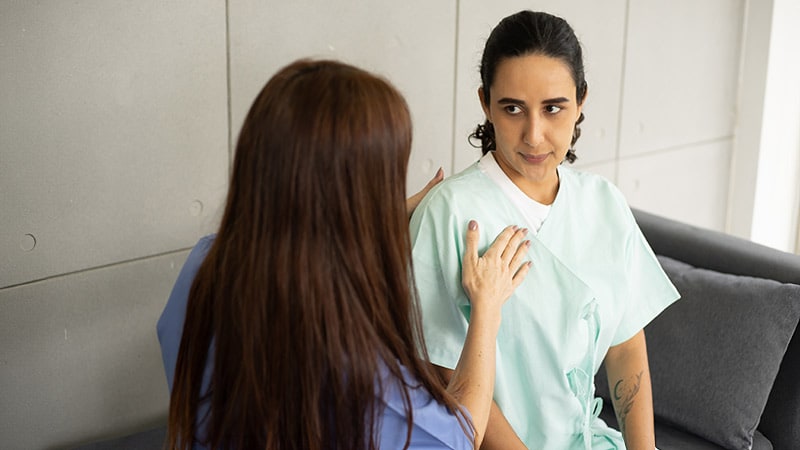Clinical Exams Ineffective for Second Breast Cancer Detection
Conceitos Básicos
Routine clinical exams are ineffective in detecting second breast cancers, emphasizing the importance of mammogram screening and patient education.
Resumo
TOPLINE:
Clinical exams detect only 2.2% of second breast cancers in women with DCIS.
METHODOLOGY:
Research shows clinical breast exams detect only 15% of second breast cancers.
Retrospective study of 1550 women with unilateral DCIS revealed low detection rates.
TAKEAWAY:
11.5% of women developed a second breast cancer within 10 years.
Mammograms detected 99.2% of cases, highlighting the importance of imaging.
IN PRACTICE:
Emphasizes the significance of mammogram screening and patient education.
SOURCE:
Study led by Bethany T. Waites published in the Journal of the National Comprehensive Cancer Network.
LIMITATIONS:
Retrospective design and the impact of the COVID-19 pandemic on surveillance patterns.
DISCLOSURES:
Study supported by Kaiser Permanente Northern California Graduate Medical Education program.
Clinical Exams Fall Short in Second Breast Cancer Detection
Estatísticas
Routine clinical examination detects only 2.2% of second breast cancers during 10-year follow-up.
Clinical breast exams only detect 15% of second breast cancers.
11.5% of women developed a second breast cancer within 10 years.
Mammogram detected 99.2% of cases.
Citações
"Our findings highlight the importance of mammogram screening and patient education regarding self-detection and can inform future NCCN recommendations for DCIS survivorship care."
Principais Insights Extraídos De
by Deepa às www.medscape.com 01-10-2024
https://www.medscape.com/viewarticle/clinical-exams-fall-short-second-breast-cancer-detection-2024a10000n2
Perguntas Mais Profundas
How can healthcare systems improve the detection rates of second breast cancers?
Healthcare systems can enhance the detection rates of second breast cancers by implementing a multifaceted approach. Firstly, increasing awareness among patients about self-detection methods and the importance of regular screenings can empower individuals to take an active role in their breast health. Additionally, healthcare providers should prioritize the promotion of regular mammogram screenings, as evidenced by the study where mammograms detected 99.2% of second breast cancers identified by imaging. Integrating advanced imaging technologies and artificial intelligence tools into routine screenings can also aid in early detection. Moreover, continuous medical education for healthcare professionals on the latest guidelines and best practices for breast cancer surveillance is crucial in improving detection rates.
What are the potential implications of relying heavily on mammogram screenings?
While mammogram screenings are highly effective in detecting breast cancer, relying solely on this method may have certain implications. One potential concern is the risk of false positives, leading to unnecessary anxiety, additional testing, and potential overtreatment. Moreover, mammograms may not be as sensitive in detecting certain types of breast cancer, particularly in women with dense breast tissue. Over-reliance on mammograms could also result in missed diagnoses, especially in cases where the cancer presents differently or is not visible on imaging. Therefore, a balanced approach that combines mammograms with other screening methods, such as clinical exams and patient self-detection, is essential for comprehensive breast cancer surveillance.
How has the COVID-19 pandemic influenced breast cancer surveillance practices?
The COVID-19 pandemic has significantly impacted breast cancer surveillance practices, potentially leading to delays in screenings and diagnoses. Due to lockdowns, restrictions, and concerns about visiting healthcare facilities, many women postponed or missed their routine mammogram appointments, resulting in a backlog of screenings. This delay in screenings could lead to the late detection of breast cancer, potentially affecting treatment outcomes and prognosis. Telemedicine and virtual consultations became more prevalent during the pandemic, offering alternative ways for healthcare providers to monitor patients remotely. However, the shift towards virtual care may have limitations in conducting thorough physical exams and imaging studies, which are crucial components of breast cancer surveillance. As healthcare systems adapt to the challenges posed by the pandemic, it is essential to prioritize resuming regular screenings and ensuring timely follow-ups for women at risk of breast cancer.
0
